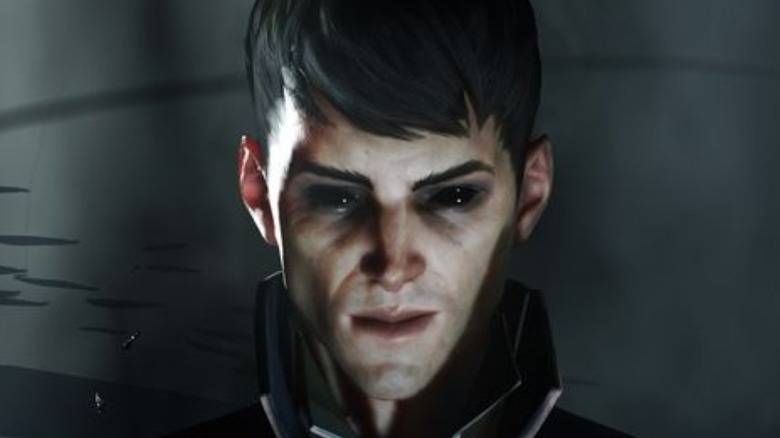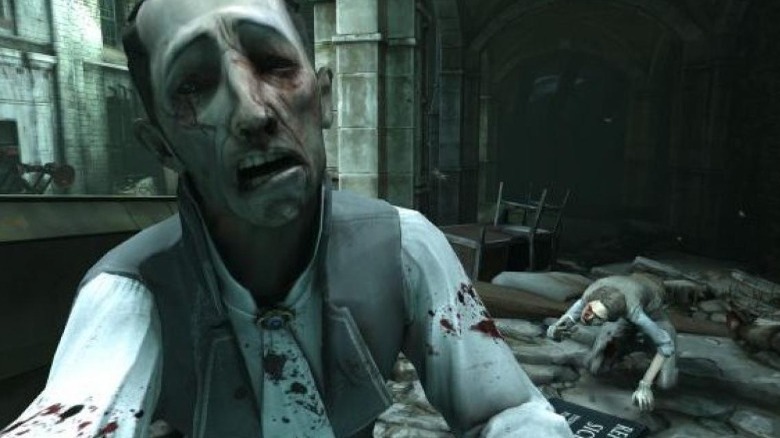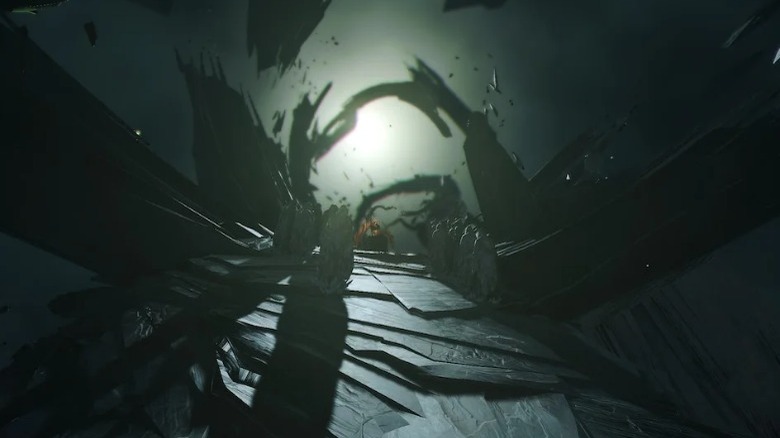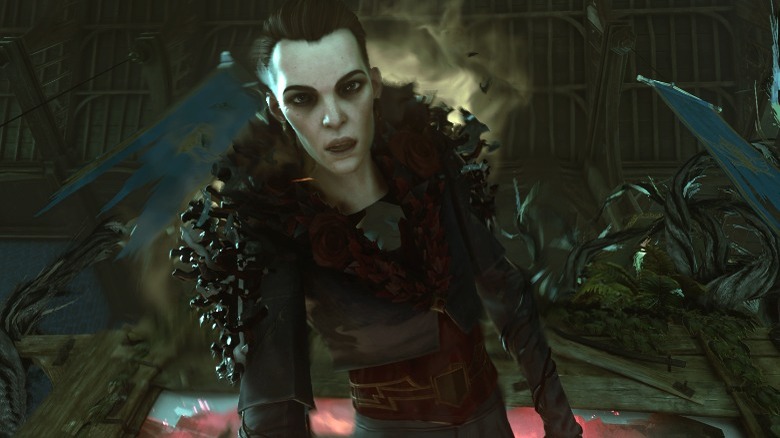The Mythology In The Dishonored Series Explained
Bethesda is one of the biggest names in gaming and it's only gotten bigger since it was acquired by Microsoft. The publisher has put out dozens of games throughout the years, but none are more well known than its RPG franchises. Bethesda reuses a lot of similar mechanics across all of these titles, but keeps each of them unique by changing up the genre and setting. The upcoming "Starfield" is set to fill the role of a hard sci-fi, space-faring adventure. "The Elder Scrolls" is a high fantasy franchise that is full of magic, demons, monsters, and gods. "Fallout" is a post-apocalyptic franchise that is set in a world ruined by nuclear war and overrun with violent mutated creatures. The Arkane Studios developed "Dishonored" series sits somewhere in the middle between sci-fi and fantasy, providing a new niche of gaming to hungry fans.
"Dishonored" is set in the heart of a decaying, industrial empire. There are heavy steampunk elements to the world. There is a lot of clockwork and whale oil-fueled technology powering the various machines and fixtures in the two cities where the games are set. While most of the world is limited to using this alternative technology, some have unlocked the secrets of magic. Here is a bit of the mythology established in the "Dishonored" series.
Plague and Pestilence
Not all of the supernatural elements in the "Dishonored" franchise are altogether magical. Both games feature dangerous fictional plagues that are carried by pests. The first game takes place in the capital city Dunwall, which is overrun with plague-carrying rats. The disease carried by these rodents is called The Doom of Pandyssia, or Rat Plague. It causes discoloration of the skin, weight loss, hair loss, and coughing, and eventually leads to those who suffer from it either dying, or becoming what is referred to in the game as weepers. Those who suffer from this late-stage variation of the infection bleed from the eyes and seem to become feral, attacking anyone who gets too close.
It is later revealed that the plague was intentionally introduced by the Royal Spymaster Hiram Burrow in an attempt to eradicate the city's poorest citizens, but the rats soon spread beyond Burrow's control and decimated the entire city's population.
"Dishonored 2" is primarily set in the coastal city of Karnaca, which suffers from a different, but equally grotesque pestilence of insects called Bloodflies. These nasty buggers build porous nests in the bodies of the dead, viciously attacking anyone that gets too close. Like the rats, Bloodflies also carry an infectious disease. Bloodfly Fever compels those who are infected to defend Bloodfly nests until they die and become the hosts for new nests themselves.
The Outsider and the Void
The protagonist, Corvo Attano witnesses the murder of Empress Jessamine Kaldwin near the beginning of the game. She was killed by a supernatural band of assassins known as The Whalers. Corvo is then framed for the murder and then has to escape from prison in order to get vengeance against those who orchestrated the coup and clear his name. It's at this point that Corvo is drawn into another dimension called The Void where he meets a mysterious figure known as The Outsider – a 4,000 year old supernatural being who grants Corvo his mark. This is the source of Corvo's magical abilities that he utilizes for the rest of the game. It is later revealed that Daud, the leader of The Whalers, was also marked by The Outsider, meaning that he is the source of their powers as well.
The Outsider isn't good or evil. He rarely contacts ordinary people, but will occasionally grant his mark when he wishes to change the course of history. He is revered by many as a god, but in reality, he is merely the conduit for the extradimensional power of The Void. It's unclear exactly how The Void is linked to the material world, but it seems to be connected to dreams and the subconscious. All of the magical abilities in "Dishonored" stem from this power.
The Brigmore Witches
Corvo and Daud weren't the only ones to receive The Outsider's Mark, however. A cult of black magic users known as The Brigmore Witches were introduced in "The Knife of Dunwall" DLC and were later the main antagonists in both "The Brigmore Witches" DLC and "Dishonored 2."
The witches are led by Delilah Copperspoon who bears the Mark of The Outsider and uses it to grant powers to her coven. Delilah is the Illegitimate daughter of Emperor Euhorn Kaldwin. Her childhood was spent in the royal estate alongside Jessamine, but she and her mother were eventually cast out to fend for themselves. This instilled a hatred for the royal family in her and was the source of her desire to usurp the throne from Emily.
Delilah's plans failed at the end of "The Brigmore Witches" and she was left to drift in The Void forever. She found the site of The Outsider's transfiguration into the conduit and used it to become a part of The Outsider himself, eventually using that power to take the throne in the beginning of the second game and turn either Emily or Corvo to stone (depending on who the player chooses to play as.)
Taking the throne isn't the end of Delilah's ambitions, however. She seeks to use the power of The Void to reshape the world in her image using a painting. This seems to make her the most powerful magic-user in the series other than The Outsider himself.




